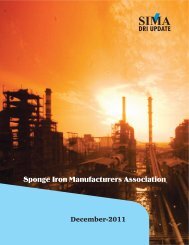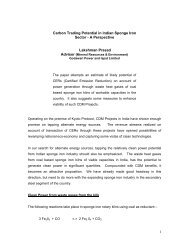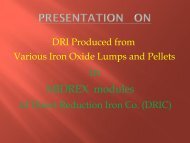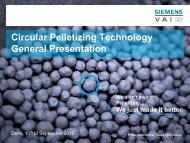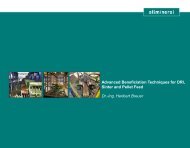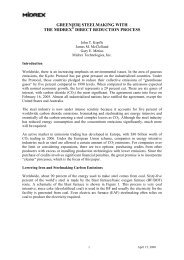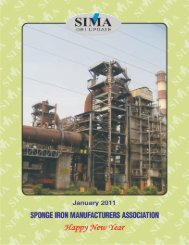Create successful ePaper yourself
Turn your PDF publications into a flip-book with our unique Google optimized e-Paper software.
Table – II<br />
Details of CERs Issued in respect of Indian Companies<br />
in Sponge Iron Sector for WHRB Projects as of 20 th March 07<br />
Sl.No. Project Developer Date of CERs Issued Verified period<br />
Issuance<br />
1 Godawari Power and Ispat Limited 04 Aug 2006 66,536 01 Sep 2002 – 31 Dec 2005<br />
2 Monnet Ispat Limited 06 Sep 2006 1,11,570 01 Jan 2005 – 31 Mar 2006<br />
3 Tata Sponge Iron Limited 27 Dec 2006 1,06,463 01 Jan 2002 – 31 Mar 2006<br />
4 Shri Bajrang Power & Ispat Limited 22 Jan <strong>2007</strong> 74,674 01 Sep 2005 – 31 Aug 2006<br />
Total CERs Issued 3,59,243<br />
In the overall assessment, taking a production of<br />
six million tonnes of sponge iron during the year<br />
2006-07 through viable CDM projects, there is a<br />
potential of producing 420 MW power through WHRB<br />
with an annual carbon credit of 1.26 million CERs.<br />
Basis : (1) waste gases from a 350 tpd kiln can<br />
produce 7 MW power<br />
(2) 1 MW power on an average can attract 3000<br />
CERs annually<br />
By the year 2011 – 12, with the anticipated doubling<br />
of production of sponge iron in India, the power<br />
generation and corresponding CERs would also be<br />
doubled to realize a credit of 2.52 million CERs<br />
annually.<br />
How to Improve viability of WHRB Systems<br />
The viability of the waste heat recovery system, in<br />
general, can be enhanced, if the following are<br />
considered :-<br />
(i) permitting open access and inter-state wheeling<br />
of power from sponge iron sector at a reasonable<br />
tariff without any stricture from the State<br />
Governments. A waste heat recovery system based<br />
on 350 TPD kiln can generate about 7 MW, out of<br />
“When everyone tries, the team flies.”<br />
which 1.5 MW can be used for captive consumption<br />
in sponge iron making and a surplus of 5.5 MW can<br />
be wheeled to the grid.<br />
(ii) reserving and making available non-coking coal<br />
of high ash fusion temperature and high reactivity<br />
for sponge iron sector.<br />
(iii) allocating iron ore mines to sponge iron<br />
manufacturers, and<br />
(iv) extending carbon credit to the manufacture of<br />
fly ash bricks.<br />
Pre-heating of kilns - another CDM option in<br />
the arena of energy efficiency<br />
As an innovative step, it may be worth exploring<br />
installing rotary pre-heating section as an adjunct<br />
to sponge iron kilns, where the waste hot gases from<br />
the kilns can pre-heat the raw materials in the kilns<br />
in the vicinity of 750oC. This would reduce heat<br />
losses entailing lower coal consumption and<br />
enhanced production of sponge iron. While the<br />
gains are yet to be quantified through some plant<br />
trials, prima facie, it could attract CDM benefits owing<br />
to significant saving of fossil fuel. These projects<br />
can be viewed in the ambit of energy efficiency<br />
measures.<br />
MAY-<strong>2007</strong>/10



